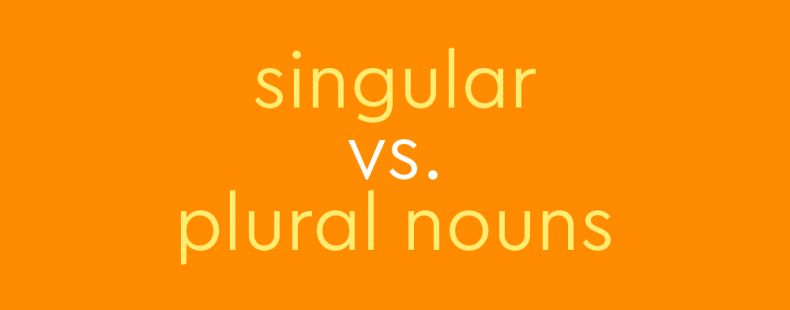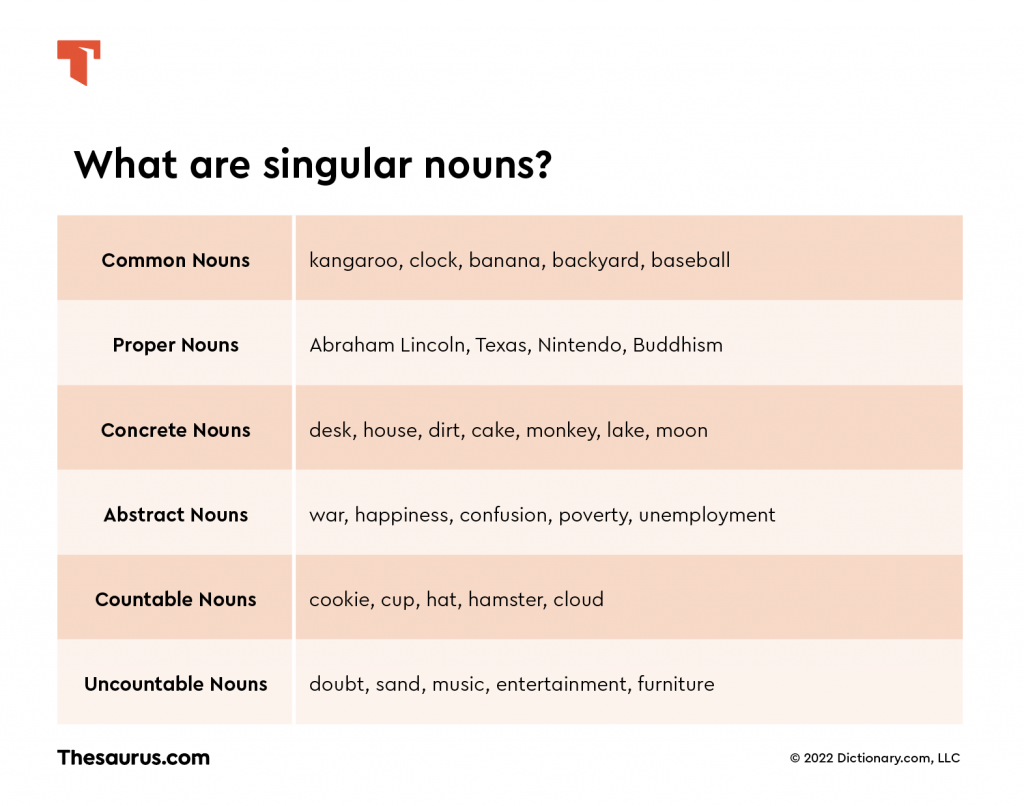In everyday life, we meet tons of interesting people, travel to a variety of unique places, and discover many fascinating things. In grammar, the type of word we use to refer to all of this great stuff is called a noun. Often, we have different amounts of stuff that we need to talk about. For example, you might have one brother or three sisters. You might own 12 cats or just a single dog. Your roommate might leave you with three slices of pizza or just one half-eaten slice—probably the one with anchovies! In all of these situations, we use two different types of nouns to refer to different amounts of stuff: singular nouns and plural nouns.

Singular noun vs. plural noun
The word singular, when used in grammar, means “noting or pertaining to a member of the category of number found in many languages that indicates that a word form has one referent or denotes one person, place, thing, or instance.” By contrast, the word plural means “noting or pertaining to a member of the category of number, found in many languages, indicating that a word has more than one referent.”
In short, this means that a singular noun refers to only one person or thing and a plural noun refers to more than one person or thing. Let’s look more closely at each of these two types of nouns so we can better understand the difference.
Singular nouns
A singular noun refers to a single object, and it is the type of noun you will almost always find if you look up nouns in our incredible Dictionary.com. Like most nouns, singular nouns can be used to refer to people, places, things, or ideas. Singular nouns always refer to one person or one thing. Singular nouns can refer to general things or more specific people, places, and things with names or titles. Singular nouns always use a singular verb and can be preceded by the articles a and an.
We’ve singled out this article on singular nouns, to give you a better understanding of them.
Examples of singular nouns
First, let’s look at many examples of singular nouns that we use to refer to a wide variety of stuff.
- people: boy, girl, child, person, actor, huntress, king, queen, Gandhi, Juliet
- places: town, city, state, country, Chicago, Switzerland, Africa
- things: apple, orange, tree, plant, animal, building, chair, desk, paper, computer
Most ideas, emotions, beliefs, philosophies, and concepts are also treated as singular nouns:
- hunger, sadness, depression, government, religion, knowledge, question, science, time
A particular type of noun to take note of is the collective noun. Collective nouns can be singular nouns even though they refer to more than person or thing. In this case, the collective noun is collectively referring to a group as if it was a single unit. Here are some examples of collective nouns:
- army, group, bunch, pile, stack, squad, team, gang, committee, jury
Plural nouns
Plural nouns are nouns that refer to more than one person, place, or thing. In general, plural nouns are made by adding -s or -es to the ends of singular nouns. However, this isn’t always the case. Sometimes a noun may change spelling or may turn into a completely different word. Plural nouns always use a plural verb in a sentence and aren’t preceded by the articles a and an.
Examples of plural nouns
Like singular nouns, plural nouns can also refer to people, places, things, and ideas.
regular plural nouns
- people: boys, girls, friends, babies, swimmers, chefs, Americans, Mongols
- places: cities, villages, islands, lakes, countries, neighborhoods, galaxies
- things: apples, oranges, vegetables, candies, chairs, trucks, buses
- ideas: questions, hopes, dreams, goals, expenses, religions, feelings, fears
irregular plural nouns
Irregular plural nouns don’t follow the rules. You will need to memorize which words are irregular plural nouns so you will be able to recognize that they are plural nouns at all.
- men, women, children, mice, lice, oxen, geese, sheep, buffalo, moose, fish, tuna, trout, salmon, teeth, feet, criteria, bacteria, data, foci, cacti, stimuli, minutiae, wolves, halves, calves
How do you use singular and plural nouns?
Grammatically, the main difference between singular and plural nouns is which type of verb you use with them. Singular nouns use singular verbs and plural nouns use plural verbs. You can see this difference in these sentences:
- My dog (singular noun) is (singular verb) big and hairy.
- In my opinion, cats (plural noun) are (plural verb) the cutest pets in the world.
- Emily (singular noun) jogs (singular verb) to work every morning.
- The ancient Romans (plural noun) were (plural verb) very powerful.
Another grammatical difference between singular and plural nouns is which articles and adjectives can be used with them. Singular nouns can use the articles a and an, but plural nouns cannot. On the other hand, plural nouns can use adjectives such as many or few that do not make grammatical sense when used with singular nouns. In this case, you will need to be able to know which nouns are singular and which are plural to use adjectives correctly.
Tips for differentiating singular vs. plural nouns
The easiest way to tell if a noun is a singular noun or a plural noun is to look at how much of something it is referring to. If it is only referring to one person or thing, it is a singular noun. If it is referring to more than one person or thing, it is a plural noun. This tip will help you even if you are dealing with those tricky collective nouns: pile is a singular noun referring to one collective group of things. Piles is a plural noun referring to more than one group of stuff.
This tip will also help you deal with those uncooperative irregular plural nouns that always break the rules. For example, the word children looks like a singular noun because it doesn’t end in -s or -es. However, the word children refers to more than one child and so it is in fact a plural noun. This tip will help with especially tough words like mice or bacteria that really don’t look like they should be plural nouns.
Finally, this tip is especially helpful when handling irregular plural nouns that are identical to their singular noun counterparts. Words like fish, moose, or species can be either singular or plural, and it will come down to the context of the sentence as to how to correctly use these words. Here are some example sentences using our tips to tell singular and plural nouns apart and to ensure that our sentences are grammatically correct:
- We are going out to see a movie. (Movie refers to a single item. It is a singular noun and can use the article a.)
- Geese swim in the lake by our house. (Geese is referring to more than one bird. It is a plural noun and uses the plural verb swim. Because it is plural, it can also stand by itself without an article.)
- She discovered a new species of ant. (Species is only referring to one thing and so it is a singular noun and can use the article a.)
- There are many different species of spiders that live in our backyard. (Species is referring to more than one group of spiders and so it is a plural noun and it uses the plural verb live.)
Perfect grammar has never been easier
There’s no room for irregularities in your own work! Improve your writing with Thesaurus.com’s Grammar Coach™, which catches grammar and spelling errors and provides Thesaurus-powered synonym suggestions. Using machine learning, this tool can definitely spot the difference between your regular and irregular nouns—and more!
Whether you’re writing about a person, place, or thing, perfect grammar has never been easier!















